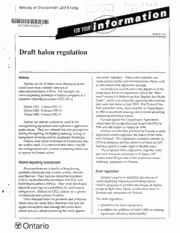
For your information : draft halon regulation PDF
Preview For your information : draft halon regulation
Ministry of Environment and Energy fl 7' ftIIi lU III!! HIJ fill H 96936000009037 yovR(j fOR MARCH 1994 Draft halon regulation S Halons ultraviolet radiation. Ultraviolet radiation can cause serious health and environmental effects such Halons can be 10 times more damaging to the as skin cancer and vegetation damage. ozone layer than a similar amount of International concern about the depletion of the chlorofluorocarbons (CFCs). For example, the ozone layer led to an agreement, called the "Mon- ozone-depleting potential of halons compared to a treal Protocol for Substances that Deplete the Ozone common chlorofluorocarbon (CFC-1 1) is: Layer", which was originally signed by 60 countries and came into force in July 1989. The Protocol has Halon-1211: 3 times CFC-11 been amended twice, most recently in Copenhagen Halon43Ol: 10 times CFC-11 in 1992 to accelerate phasing out of ozone-depleting Halon-2402: 6 times CFC-1 1 substances including halons. Canada signed the Copenhagen Agreement Halotis are almost exclusively used in fire which bans the production and import of CFCs in extinguishing equipment and explosion suppression 1996 and the import of halons in 1994. applications. They are released into the atmosphere Ontario was the first province in Canada to pass during firefighting, firefighting training, testing or legislation which supported the intent of the Mon- equipment servicing and by accidental discharges. treal Protocol. This legislation included controls on Halons were never produced in Canada but they CFCs in aerosols, and the phase-in of bans on CFC are widely used. It is estimated that about 140,000 foaming agents to make rigid or flexible foam. fire extinguishers and systems containing halons are The proposed halon regulation, together with in service in Ontario alone. previous measures proposed or in place, will control about 95 per cent of the sources of ozone- Ozone-depleting substances depleting substances in Ontario. Fluorocarbons are a family of long-lasting synthetic chemicals that contain carbon, chlorine Draft regulation and fluorine. They include chlorofluorocarbons Ontario's goal is to minimize the release of (CFCs), hydrochlorofluorocarbons (HCFCs) and ozone-depleting substances including halons. hydrofluorocarbons (HFCs). They were developed Ontario proposes to prohibit the release of halons about 60 years ago as a substitute for ammonia in except to fight fires, which would allow time to refrigerators. Related to CFCs, halons are •a group develop safe substitutes for halons. of chemicals that contain bromine. Once released from the products and processes The draft regulation: where they are used, these chemicals rise into the • prohibits new halon equipment upper atmosphere and damage the pzone layer which acts as a shield protecting the earth against • prohibits the addition of Halon-2402 to existing equipment (effective immediately) Copyright Provisions and Restrictions on Copying: This Ontario Ministry of the Environment work is protected by Crown copyright (unless otherwise indicated), which is held by the Queen's Printer for Ontario. It may be reproduced for non-commercial purposes if credit is given and Crown copyright is acknowledged. It may not be reproduced, in all or in part, for any commercial purpose except under a licence from the Queen's Printer for Ontario. For information on reproducing Government of Ontario works, please contact ServiceOntario Publications at • prohibits the sale of new extinguishers smaller than 3 kilograms with halons after 1995 • prohibits the refill of extinguishers smaller than 3 kilograms with halons after 1995 • prohibits the addition of HCFCs and !-IBFCs (hydrobromofluorocarbons) to fire extinguish- ing equipment after 1996 • requires the use of certified halon companies to service halon equipment, to store halons and to dispose of halon equipment (applies to fire extinguishers larger than 3 kilograms) • • requires that certified companies meet Under- • writers Laboratories of Canada standards t • requires that large extinguishers or systems • (greater than 3 kilograms) must be certified empty before being disposed of • exempts small extinguishers (less than 3 kilograms) from disposal requirements. Controlled use of halons to fight fires will be permitted. However, discharging halon equipment for the purpose of training firefighters will not be allowed. Existing extinguishers and systems can continue to be used by industry and householders, but small fire extinguishers cannot be recharged after 1995. The sale of new fire extinguishers and systems containing halons would be prohibited immedIately. The proposed regulation does not require homeowners to dispose of or hand over their portable fire extinguishers. Householders should maintain them in accordance with manufacturers' instructions. Only companies certified by Underwriters Laboratories of Canada will be allowed to service halon fire extinguishing equipment, to recondition or to store halons. Standards have been developed to minimize the loss of halons to the environment. If you require information on the servicing, dismantling or removal of halon equipment, or need information on the supply, storage or recondi- tioning of halons, contact the Underwriters Labora- tories of Canada at 1-8004638244. ULC is a non- profit standard organization, under the Standards Council of Canada, that will give you the name o an approved company. Copies of the draft regulation can be obtained V • at the Ministry of Environment and Public Ii existe une version francaise de cette publication. Pour Information Centre, 135 St. Clair Ave. W., Toronto, en obtenir un exemplaire, communiquez avec le Centre Ont., M4V IFS, tel: (416) 323-4321 or call toll free d'information au 1-800-565-4923, ou par télécopieur au, 1-800-565-4923. (416) 323-4564; PIGS 28S4b Printed on recycled
